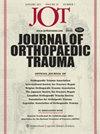股骨颈外翻撞击性骨折(OTA 31B1.1 型)后,螺钉配置不会显著改变股骨颈缩短程度
IF 1.6
3区 医学
Q3 ORTHOPEDICS
引用次数: 0
摘要
比较用于治疗 Garden 1 股骨颈骨折 (FNF) 的三种不同松质骨螺钉配置。 设计:回顾性研究。 一家大型城市学术医疗中心。 纳入2012年至2021年间接受松质骨螺钉原位固定术的所有OTA 31B1.1 股骨颈骨折患者。患者被分为三组:平行放置两枚螺钉、倒三角形配置放置三枚螺钉,以及垂直于股骨长轴放置一枚 "平面外"(OOP)螺钉的三枚螺钉固定。 术后股骨颈缩短(毫米)是三组不同螺钉配置之间的主要结果比较。 61名患者的中位随访时间为1年(IQR为0.6-1.8年),平均年龄为72岁(IQR为65.0-83.0岁)。所有骨折均为合并骨折。总体而言,68.9%的患者股骨颈缩短≤2毫米。在股骨颈缩短超过2毫米的患者比例(P = 0.839)或股骨颈缩短量(毫米)(Kruskal-Wallis χ2 = 0.517,P = 0.772)方面,组间没有差异。 虽然大多数股骨颈外翻骨折患者在接受螺钉固定治疗后股骨颈不会进一步缩短,但有些患者在愈合过程中仍会出现影像学上的股骨颈缩短。股骨颈进一步缩短的情况和缩短的程度并不因植入物的配置而异。多种不同的螺钉结构在实现愈合和减少股骨颈进一步嵌顿方面似乎是可以接受的。 预后三级。有关证据等级的完整描述,请参阅 "作者须知"。本文章由计算机程序翻译,如有差异,请以英文原文为准。
Screw Configuration Does Not Significantly Alter Neck Shortening Following Valgus Impacted Femoral Neck Fracture (OTA Type 31B1.1)
To compare three different cancellous screw configurations used for Garden 1 femoral neck fractures (FNF).
Design: Retrospective review.
A large urban academic medical center.
All patients with OTA 31B1.1 FNF that underwent in situ fixation with cancellous screws between 2012 and 2021 were included. Patients were divided into three groups: two screws placed in a parallel fashion, three screws placed in an inverted triangle configuration, and three-screw fixation with placement of one “out of plane” (OOP) screw perpendicular to the long axis of the femur.
Post operative femoral neck shortening (mm) was the primary outcome, which was compared amongst the three groups of different screw configurations.
Sixty-one patients with a median follow-up of 1 year (IQR 0.6-1.8 years) and an average age of 72 years (IQR 65.0-83.0 years) were included. All fractures united. Overall, 68.9% of the cohort had ≤ 2 mm of femoral neck shortening. There was no difference between groups in the proportion of patients who experienced greater than 2 mm of shortening (p = 0.839) or in the amount (mm) of femoral neck shortening (Kruskal-Wallis χ2 = 0.517, p = 0.772).
While most patients with valgus impacted femoral neck fractures treated with screw fixation do not experience further femoral neck shortening, some patients demonstrated continued radiographic shortening during the healing process. The development of further femoral neck shortening and the amount of shortening that occurs do not differ based on implant configuration. Multiple different screw configurations appear to be acceptable with regards to achieving healing and minimizing further femoral neck impaction.
Prognostic Level III. See Instructions for Authors for a complete description of levels of evidence.
求助全文
通过发布文献求助,成功后即可免费获取论文全文。
去求助
来源期刊

Journal of Orthopaedic Trauma
医学-运动科学
CiteScore
3.90
自引率
8.70%
发文量
396
审稿时长
3-8 weeks
期刊介绍:
Journal of Orthopaedic Trauma is devoted exclusively to the diagnosis and management of hard and soft tissue trauma, including injuries to bone, muscle, ligament, and tendons, as well as spinal cord injuries. Under the guidance of a distinguished international board of editors, the journal provides the most current information on diagnostic techniques, new and improved surgical instruments and procedures, surgical implants and prosthetic devices, bioplastics and biometals; and physical therapy and rehabilitation.
 求助内容:
求助内容: 应助结果提醒方式:
应助结果提醒方式:


